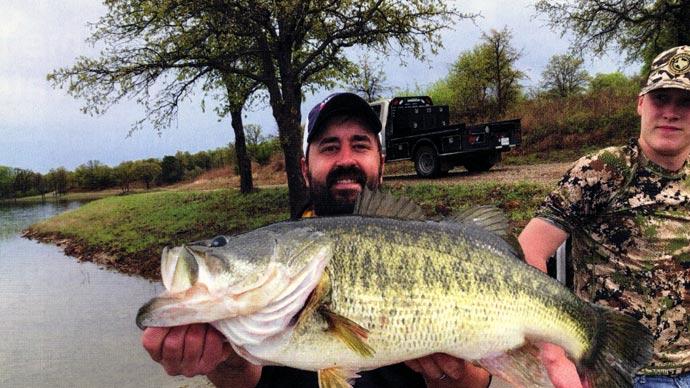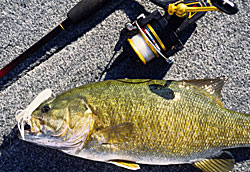
More bass have probably been caught on a tube bait than another lure. Why? “It imitates every type of forage that a bass eats. Perch, crayfish, gobies, shad, you name it,” said guide and bass pro Art Ferguson III. “Plus, it’s one of the most versatile baits you could ever use.”
The original Gitzit was the genesis of the tube jig. Bass lure innovator Bobby Garland should be credited for designing the first tube jig. Garland was continually scheming and inventing via his Bass ‘N Man Lure Company back in the ’70s and 80’s. The first news of the Gitzit came after Garland won a Western Bass tournament on Lake Havasu in the fall of 1980. Word spread like a California wildfire about this new lure called Fat Gitzit. Garland designed the lure to fall in a spiraling action to imitate a dying shad. Rigged on a 1/16-ounce jig head, the Gitzit also proved to be an excellent crayfish imitation.

It was three or four years before the lure caught on back east. Bass historians believe that Garland gave Guido Hibdon a supply of Gitzits to use at the 1984 Table Rock tournament, an event he won. Soon, anglers like Denny Brauer and Tommy Biffle were using fat tubes to win B.A.S.S. events, and tube hysteria became contagious.
Today, nearly every plastic manufacturer makes a version of the Gitzit. Garry Garland, Bobby’s brother, makes a refined version of the Gitzit that uses a process whereby the tentacles on the tubes are cut with a machine instead of molded. The process makes tentacles on the tubes finer, more consistent, and one of the best on the market. Other prominent tube manufacturers include Gary Yamamoto Custom Baits, Luck "E" Strike, and Strike King.
Four-time Bassmaster Classic and four-time FLW Championship qualifier Art Ferguson III has guided bass anglers for over 25 years and has relied on tube baits as his go-to bait. Ferguson primarily guides on Lake St. Clair in Michigan and Florida waters during the winter. He also fishes bass tournaments all over the country and finds that wherever he goes, tubes rock.
“The beauty of a tube is the variety of ways you can fish it,” Ferguson said. “You can drag it, flip it, swim it, fish it with a Carolina rig, Texas–rig it or drop shot with it, even fish it on top, and you’re going to catch fish.” That’s why a tube is a good choice when guiding. Clients can’t fish a tube wrong, and whatever they do with it, they’re likely to catch fish.
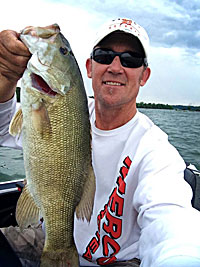
“I’ve been doing more drop-shotting with tubes,” Ferguson said. “I never used to use tubes when to drop shotting, but it’s a deadly technique.” Ferguson also said that he’s been catching more bass these days by swimming tubes.
Although tubes imitate a variety of forage, it’s important to “match the hatch” when possible. Ferguson told me that he was pre-fishing for a tournament and went into a bay off the lake to explore. With his polarized glasses, he could see that the bottom of the bay was a strange color. He dropped his jig down and pulled up a crayfish attached to it. Then, he realized that the bottom was crawling with newly hatched crayfish. Thousands of them! Ferguson said he dropped the live crayfish on the deck and pulled out his tube assortment. He found one that matched the length and coloration of the live crayfish to a tee. 99% of the bass he caught during the tournament were caught on that identical tube, enough to place second in the tournament.
Crawfish are like candy to a bass. Crawdads are found in every body of water with bass, so they’re accustomed to seeing them. Tubes do an outstanding job of imitating crayfish if you think about it. When a crayfish is alarmed and scoots backward, it looks like a tube. A crayfish’s tail is tucked under its body, giving it a rounded appearance, and its claws are drawn in behind its body, producing a slim profile. The tentacles on a tube simulate the claws of a panicked, fleeing crustacean.
Tubes also do a great job imitating a crawdad in defense mode. Crayfish often stand their ground when they are threatened. The crawdad’s claws come up in a defensive posture, and it tries to back up into cover. A tube can appear strikingly similar to a defensive crayfish. Because of its semi-buoyant hollow body, air can get trapped in a tube and cause it to take a tentacles-up attitude like a retreating crawdad. Add the element of scent and a rattle, and you have one of the most convincing crayfish imitations ever made.
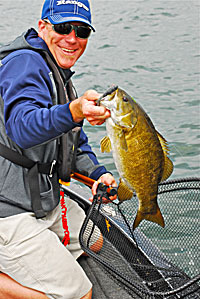
Color is critical. Bass often regurgitate what they’re eaten when you get them in the boat. If it’s a crawdad, make a note of the size and color of the bait and match the color of your tube to the real thing. Generally, dark colors like pumpkin, watermelon, and motor oil, mixed with other highlights, do an excellent job of imitating crayfish. These same colors do a great job of imitating gobies, darters, and sculpins for anglers that fish the Great Lakes for bass.
When I first fished with Ferguson 20 years ago, we didn’t use dark-colored tubes. That was before zebra mussels and gobies' days and Lake St. Clair became super clear, and weeds began growing in deeper water. Crayfish numbers exploded due to more vegetation being available for food and cover. The tube of choice back then was pearl, smoke, and white glitter to imitate the bait de jour – shad and shiners. Those colors still work well when bass are keying on baitfish. Ferguson shared that when fishing inland lakes for largemouth, he’ll use tubes in combinations of black, blue, and red highlights. Watermelon and pumpkin with chartreuse and purple flake are good, too.
An admitted tubeaholic, Ferguson started marketing his brand of tubes, jigs, drop-shot weights, swim baits, and A-rigs on his website, Provider Tackle, which offers some of the best tubes and terminal tackle on the market.
One of Ferguson’s inventions, his Performance Series Tube Heads, is a relatively unknown secret to catching big numbers of bass on tubes. “It’s essential that your tube swims straight or falls straight down when you cast it out,” Ferguson said. “If the jig is spiraling as it falls or twirls and spins as you retrieve it, you’re going to get line twist. With the Performance Head, you’re not going to get the twist. Plus, the tube doesn’t look natural when doing that.”
The secret to the Performance Series Head is that it’s designed off-center, so it’s heavier on the bottom to act as a keel on the jig. That makes it swim and fall straight. “I’ve been swimming tubes more than ever,” said Ferguson. “When I first came out with the Performance Head, I won swimming tubes in two tournaments in a row.”
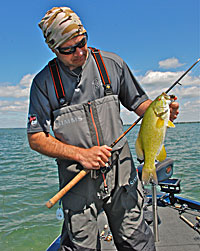
Ferguson makes the heads in size from 1/8 to ¾ ounce. The jigs are made with 2/0 Owner hooks on the 1/8-, 3/16- and ¼-ounce models and 3/0 Owner hooks on the 3/8- to ¾-ounce jigs. Ferguson claims the 1/8- through ¼- ounce jigs are perfect for fishing grass, swimming, shallow water, and sight-fishing beds. The 3/8-pounce head is ideal for dragging and maintaining contact with the bottom. ½-, 5/8- and 3/4-ounce jigs are suitable when fishing rocks, gravel, in current, when long casts are required, or when fishing vertical in deep water.
Ferguson recommends using small hooks. “The smaller hook provides a smaller profile,” said Ferguson. “The smaller hook is more conducive to catch and release, the hook is closer to the head then, which is where a bass usually strikes, and the smaller hook pulls through weeds and over rocks better.” Most anglers use 3/0 to 5/0 hooks when using tubes.
Ferguson’s tubes are super soft, subtle, and uniformly round, although he admits no two tubes are the same. Each tube has 18 finely cut tentacles that pulsate with the slightest movement. Ferguson said a good tube should feature a ratio of 60% body versus 40% tentacles.
“The rounder, the better when it comes to tubes,” he said. He invests in a little more expensive packaging to keep the hollow bodies of the tubes cylindrical. He packages the tubes in a salted mix of garlic/fish oil/crayfish attractant. “The stuff stinks,” he joked, “but I think it makes a difference. The salt makes the tube float and keeps it soft.”
Ferguson said that the fat 3.5-inch tube is the most popular and productive. “If you think about it, everything a bass eats is 3 to 4 inches, be it a perch, crayfish, goby, or shad.” Provider Tackle tubes are available in various colors in 3.5-inch slim and fat versions and a 4-inch fat tube. Ferguson admitted that the fiesta melon has been the best-selling color of all the tube colors in the past year.
Tubes have all the qualifications of a top-notch bass lure. They have the feel, appearance, and action that make them tube-a-licious to a bass.
BassResource may receive a portion of revenues if you make a purchase using a link above.



